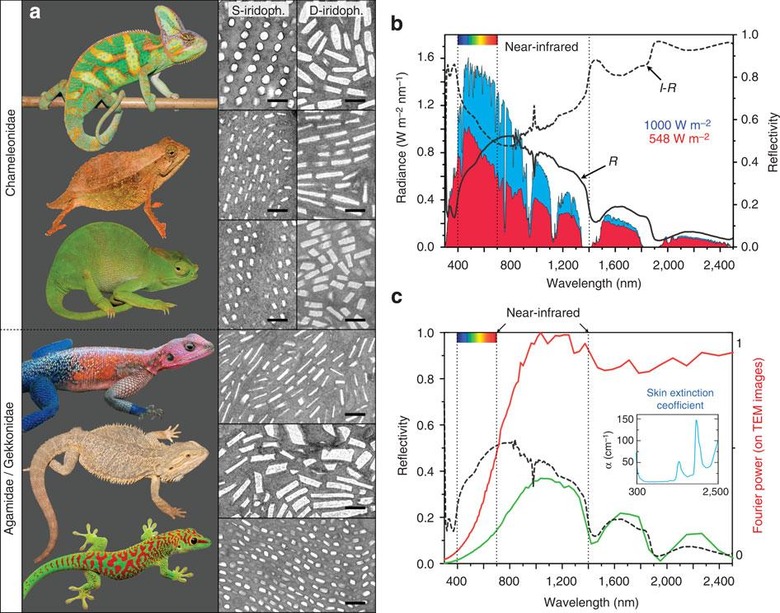Chameleon Color Changing Abilities Unlocked By Science
A paper has been published this week in Nature Communications which shows how chameleons are able to swiftly and radically alter their exterior colors. Believe it or not, this study is brand new – science did not know how a creature like the Panther Chameleon was able to change colors based on emotion or surroundings. In addition to uncovering the secrets of miniature nanocrystals for color change, these scientists also uncovered another reason for their existence: passive thermal protection (made to keep cool).
According to a paper published today – and received back in June of 2014 – "dispersion/aggregation of pigment-containing organelles within dermal chromatophores" was (until now) the generally accepted hypothesis for why/how chameleons change color.
This crew of scientists used combining microscopy, photometric videography and photonic band-gap modelling to create a new proof for how the color shift in chameleon skin takes place. According to this paper, chameleons are able to shift their color through "active tuning of a lattice of guanine nanocrystals within a superficial thick layer of dermal iridophores."
An iridophore is a kind of Chromatophore, or a light-reflecting cell with pigment inside. Several subclasses of chromatophores exist:
• xanthophores (yellow)
• erythrophores (red)
• leucophores (white)
• melanophores (black/brown)
• cyanophores (blue).
• iridophores (reflective / iridescent)

Above: Figure 1: Colour change and iridophore types in panther chameleons. "Reversible colour change is shown for two males (m1 and m2): during excitation (white arrows), background skin shifts from the baseline state (green) to yellow/orange and both vertical bars and horizontal mid-body stripe shift from blue to whitish (m1)."

Above: Figure 1: Colour change and iridophore types in panther chameleons ( part 2) . "(b) Red dots: time evolution in the CIE chromaticity chart of a third male with green skin in a high-resolution video (Supplementary Movie 3); dashed white line: optical response in numerical simulations using a face-centred cubic (FCC) lattice of guanine crystals with lattice parameter indicated with black arrows. (c) Haematoxylin and eosin staining of a cross-section of white skin showing the epidermis (ep) and the two thick layers of iridophores. (d) TEM images of guanine nanocrystals in S-iridophores in the excited state and three-dimensional model of an FCC lattice (shown in two orientations). (e) TEM image of guanine nanocrystals in D-iridophores. Scale bars, 20 μm (c); 200 nm (d,e)."
Two superposed layers of iridophores exist on chameleons, creating what these scientists suggest is an "evolutionary novelty," providing these creatures with both a means of camouflage and a rather flashy way to attract mates.
The paper shows that larger crystals organized in deeper populations of iridophores on chameleons reflect more substantial amounts of sunlight. This sunlight is reflected especially in the near-infrared range.

In addition to camouflage and display, these scientists suggest that the makeup of chameleon skin provides some passive thermal protection.
Supplementary Video 1 shows "In vivo colour change in a F. pardalis adult male under excitation upon presentation of another adult male in its vision field. The original video is stabilised and accelerated 8 times."
Supplementary Video 2 shows "Ex vivo colour change of an adult male F. pardalis white skin sample induced by increasing osmolarity of the medium from 236 mOsm to 944 mOsm. The original video is accelerated 30×. The inset shows a 10× magnification of a single cell. This experiment indicates that individual Siridophores experience a gradual shift in colour across the whole visible spectrum."
This information comes from the paper "Photonic crystals cause active colour change in chameleons" written by Jérémie Teyssier, Suzanne V. Saenko, Dirk van der Marel, & Michel C. Milinkovitch. You can take a peek at the full paper as published in the journal Nature Magazine.
